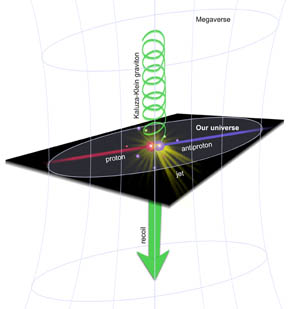 DZero: Particle Pairs and Monojets
The hypothesis of extra dimensions in space large enough to be detectable by existing or near-future experiments is by far the most revolutionary attempt to solve the hierarchy problem of the Standard Model. No wonder it has captured the public's imagination and inspired experimentalists around the world.
In 2000, DZero pioneered searches for extra dimensions at proton colliders by looking for anomalies in the production of pairs of electrons and photons due to the effects of gravitational interaction amplified by extra space. Two years later DZero was first to look for production of "monojets"—single remnants of a quark or a gluon recoiling against the invisible graviton disappearing in extra dimensions.
Now, with the higher energy of the Tevatron and more data, DZero continues the quest. In the new result unveiled at Lepton-Photon 2003, DZero has extended the search by looking for pairs of electrons, photons, and muons and set the most stringent limits on their existence to date.
While no evidence for extra space has been found so far, we plan to increase our sensitivity by another factor of two in the next three years.
|
|
 CDF: The Bulk and The Brane
We may live in a world that has more than the usual four dimensions (one time dimension + 3 space dimensions) of our everyday experience. Indeed, one way to explain the peculiar properties of gravity is that the universe extends in 4+n dimensional space (the bulk) while we are trapped in the familiar 4 dimensional world (the brane).
Our web site illustrates a proton and antiproton colliding in the brane to send a graviton out of the brane, carrying away energy and momentum. We observe the "missing energy" signature of this escaping graviton (called a Kaluza-Klein particle), similar to the way the existence of neutrinos is inferred in collider experiments.
The result of our analysis is to constrain at 95% confidence level the value of the effective Planck Scale for 2,4, and 6 extra dimensions to be greater than 1 TeV, 0.77 TeV, and 0.71 TeV, respectively, the best result from a direct graviton emission search at the Tevatron.
Note that the Tevatron is now running at a higher energy (approximately 2 TeV) and that we will soon have many times the data sample analyzed here. This will make us sensitive to an effective Planck Scale as high as 1.5 TeV
for two extra dimensions.
|

